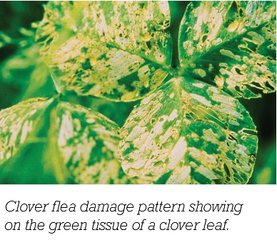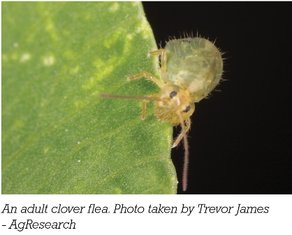Clover flea
Clover flea (CF) is present throughout NZ and is a particular threat to white clover and lucerne. Severe damage has been reported in parts of Northland, South Auckland, Waikato and the Bay of Plenty.
Identification
CF, also known as the lucerne flea or springtails, can easily be seen with the naked eye. It grows up to 3 mm long, and is greenish-yellow with irregular dark patches.
Adult females lay very small cream coloured eggs loose on the soil surface. The eggs hatch into small nymphs which resemble adults, and develop through 5-7 stages to adulthood.
Clover damage appears as leaf flecking, giving a measles-like effect. Under severe attack leaves appear white, as all green tissue is removed from the leaf leaving a transparent skeleton.
The fouling of the clover by the fleas tends to reduce palatability to livestock.

Prevention and management
CF can be successfully controlled using insecticides, by combining a low rate of insecticide to kill adults and an insect growth regulator to eliminate juveniles once they hatch from eggs.
Keep your clover healthy through good pasture management. This helps it tolerate a low level of CF.


